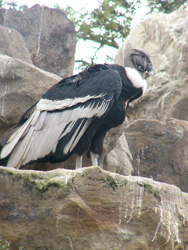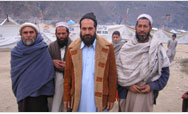You are here » Home » Telling Our Story
Case Study
Bioreserve protects endangered species, supports communities
Protecting People, Animals, and Land

| |
Photo: Fredy Condoy
|
|
The Condor, pictured at Guayllabamba National Zoo north of Quito, Ecuador, has a 12-foot wingspan. USAID efforts are helping to conserve its natural habitat in northern Ecuador.
In Oyacachi, a village in the Condor Bioreserve about 50 miles east of Quito, improvements in livestock management and a better understanding of local bear habitats reduced the number of bear attacks on cattle from 20 to four in one year.
|
Challenge
Northern Ecuador’s Condor Bioreserve stretches from Andean grasslands to Amazon rainforests. Its mountain streams trickle into rivers that supply water to the capital of Quito. The region is a sanctuary for the endangered spectacled bear and the Andean condor, the world’s largest flying bird. A top conservation priority, the bioreserve is threatened by unsustainable farming, over-grazing, logging, illegal hunting, and intentionally set fires. Local communities depend on natural resources to survive, yet come into conflict with wildlife when bears attack cattle pasturing near their habitat, costing families thousands of dollars a year.
Initiative
USAID is working to protect the reserve through several initiatives. Programs in several villages hire, train, and equip residents to be park rangers and provide guard stations, two-way radios, patrol vehicles, and training on habitat protection. Local residents learn how to reduce poaching, illegal logging, and fires. Other programs focus on promoting ecotourism, which can bring revenue through low-impact activities like nature hikes, controlled sport fishing, and camping. USAID is also supporting efforts to study bear habitats to help farmers identify less vulnerable locations for raising their livestock.
Results
The results have been remarkable. About two years into the program, deforestation has declined and the number of intentionally set fires has dropped 35 percent. Illegal hunting and fishing have been curtailed as local communities increasingly realize the benefits of ecotourism. Identification of bear habitats, which has helped herders find safer grazing grounds, has led to a drop in the number of livestock attacks. The village of Oyacachi had only four incidents in 2004, down from 20 the year before. By working to protect the environment, endangered native species, and the livelihoods of local residents, USAID is helping preserve an important ecological and cultural area of Ecuador so that future generations can continue to benefit from its wealth.
Print-friendly version of this page (533kb - PDF)
Click here for high-res photo
Back to Top ^ | 

